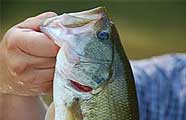All About Bass Fishing - Guide To Fishing In Spring
By Rick Seaman and Dan Westfall
 Spring brings warmer weather which begins warming the lake water. The shallowest areas of the lake warm the quickest, with areas on the north and east sections of the lake warming first. Dirty water warms quicker than clear water as the particles in the water absorb heat from the sun. Because the river areas are significantly shallower than the main body of the lake, this is a good area to begin your search for warmer water. Bass begin moving back into these shallow areas to start the spawning process. The spawn is divided into three phases – pre-spawn, spawn and post-spawn. While the spawn cycle lasts about six to eight weeks for a given bass, the overall spawn may last several months as bass do not all spawn at the same time.
Spring brings warmer weather which begins warming the lake water. The shallowest areas of the lake warm the quickest, with areas on the north and east sections of the lake warming first. Dirty water warms quicker than clear water as the particles in the water absorb heat from the sun. Because the river areas are significantly shallower than the main body of the lake, this is a good area to begin your search for warmer water. Bass begin moving back into these shallow areas to start the spawning process. The spawn is divided into three phases – pre-spawn, spawn and post-spawn. While the spawn cycle lasts about six to eight weeks for a given bass, the overall spawn may last several months as bass do not all spawn at the same time.
 During pre-spawn the bass are concentrating on feeding in preparation for the grueling activities of spawn. Sunfish, crawfish, frogs, fish and other high-protein food sources are their primary targets – including smaller bass. They tend to forage near the area they will nest, in part to remove some of the egg predators from the area to make the nest safer once the eggs have been laid.
During pre-spawn the bass are concentrating on feeding in preparation for the grueling activities of spawn. Sunfish, crawfish, frogs, fish and other high-protein food sources are their primary targets – including smaller bass. They tend to forage near the area they will nest, in part to remove some of the egg predators from the area to make the nest safer once the eggs have been laid.
The spawn is a time when bass are very vulnerable as they quit feeding and go into a full protection mode. The males begin building nests by fanning silt and debris from an area one to three feet in diameter to create a nest. These nests are typically in three to ten feet of water. The ideal areas are those with rocky or sandy bottoms with cover elements like brush or boulders. Areas protected from wind and traffic are also preferred. In some areas with silted or muddy bottoms, bass will elect to lay eggs on large wood or boulders. Once the nests are established, the males invite females to the nest. Females may lay eggs in more than one male’s nest, which is nature’s way of ensuring that if one nest fails the others populate the species. After laying the eggs, the female retreats to deeper water to recover from the strenuous activity of the spawn. The male stays on the nest and guards the eggs until they hatch and continues guarding the fry for some time. Before retreating to deep water to recover, the male turns on the fry eating some of them to let them know everything that moves will attempt to eat them. This causes the fry to head for cover and learn how to survive in these treacherous waters.
The post-spawn is a period of approximately two weeks of recovery before returning to normal activities. Once this resting period is over, males and females alike begin feeding heavily to regain the bulk they lost during the spawn. During this time the bass tend to stay at shallow depths moving into shallow areas feeding on sunfish and baitfish which spawn after the bass are finished. When they move out of the shallows they are likely to stay at the same depth but suspend over deeper water as a holding place.
3 Most Important Factors About Bass Activity in Spring
- The bass move into warming shallows in preparation for the spawn.
- Bass gorge themselves on high protein food sources (sunfish, crawfish, frogs and etc) before the spawn.
- During the spawn bass do not eat but will attack lures to protect the nest, eggs and fry.
3 Most Effective Fishing Methods & Lures
- Spinnerbaits.
- Crankbaits.
- Texas-style worms.
A Day On The Lake During Spring
Particularly at this time of year it is important to know what stage of spawning activity is prevalent at the lake where you plan to fish. Begin by accumulating local knowledge about the body of water you will be fishing. Contact local bait stores, bass boat dealers and bass club members to find out first hand what is happening at the lake. Check fishing reports and fishing blogs which cover the lake where you plan to fish. The local fish and game department often posts fishing reports. While most agree 65 degrees is the ideal water temperature for spawning, it can vary throughout regions and even within a given lake. Knowing the water temperature where the bass currently seem the most productive, can be very helpful.
Recommended Gear And Tackle
Rod Choices (in order of importance)
1. 6’ medium-heavy action, bait-casting rod for lures from 3/8 ounce up to 3/4 ounce. Fill reel with 40# to 50# braid or 14# to 17# monofilament or fluorocarbon. (To be used for spinnerbaits and worms).
2. 6’ medium-action, bait-casting rod for lures from ¼ ounce up to 3/4 ounce. Fill reel with 30# to 40# braid or 12# to 14# monofilament or fluorocarbon. (To be used for crankbaits, plastics and top water).
Lure Choices (in order of importance)
An assortment of ¼ ounce to 1/2 ounce spinnerbaits.
An assortment of plastic soft jerkbaits and other baitfish imitators.
An assortment of shallow to medium-running crankbaits and lipless crankbaits.
An assortment of top water lures.
An assortment of 4” to 6” worms for Texas-style worm fishing.
Locating Bass During Pre-spawn
Armed with local information, head to the backs of coves and into the river areas of the lake. In these shallows, the bass will seek out whatever cover is available. In river areas the bass will seek backwaters away from the channel if current exists. Dirty water will probably be more productive than clear water during pre-spawn. In early spring seek these areas on the northern and eastern sections of the lake if possible as these areas will warm first. As the day warms, the bass tend to move shallower in search of the warmer water which also attracts the bait and forage fish. Water color often dictates which lures might be most effective. As a rule, spinnerbaits and high-wobble crankbaits work best in dirty water. Top water, and crankbaits with less wobble, work better in clearer water. In dirty water it is important to retrieve your lure tight to cover and work the lure at a slower pace. Slow retrieves work best as the water is still quite cool. Vary the speed and motion of retrieve until you find what works best. Spinnerbaits allow you to retrieve the lure through thick cover to draw bass out. With crankbaits cast close to the outer edges of brush, rocks or other cover. For spinnerbaits, chartreuse in dirty water and white in clear water has always been the standard. For crankbaits, attempt to match the local forage fish and add contrast colors in dirty water. The three most popular crankbait colors are shad colors, crawfish colors and chartreuse. Red Rattletraps are also popular in many areas this time of year.
Locating Bass During The Spawn
Bass will be in the same general areas as the pre-spawn phase. They will spawn in water from three feet to ten feet deep or more. Sun penetration to the nest is required to hatch the eggs. If the water is clear enough, spawning bass may be able to be seen in and around their nest. Polarized glasses make it much easier to see these nesting bass. These bass can be difficult to catch and require a lot of patience on the part of the angler. Note that in some areas it is illegal to fish for nesting bass. The most effective method is to tease the nesting bass into removing your bait from the nest. It is important to use a color you can see well, white works in most cases. Small plastics are preferred. It may take multiple casts to the same spot to entice the bass to react. Keep prop wash from your trolling motor away from the nest.
Locating Bass During Post-spawn
The first two weeks or so the bass are likely to be inactive, resting from the spawn experience. The period following this resting can be some of the most aggressive feeding of the year. The bass feed in the shallows and when not feeding suspend in the underwater trees, brush, grass or other cover in mid depths. These bass will chase lures some distance away from their hiding spots, often as far as thirty feet in clear water. Shallow running crankbaits, lipless crankbaits, spinnerbaits, top water and plastics fished shallow will attract these hungry bass. This is a perfect time of year to catch bass on a soft jerkbait fished very shallow - even over deeper cover. If there is a hungry bass nearby, they will charge your presentation. Be sure to fish from right on the bank out to where the tops of submerged trees are ten feet deep or more.
AA Bass Fishing Knowledge Base
- Bass Fishing Overview
- Life Cycle Of Bass
- Seasonal Bass Migration
- Bass Migration - Mid to Late Winter
- Bass Migration - Spring
- Bass Migration - Early Summer
- Bass Migration - Late Summer
- Bass Migration - Fall
- Bass Migration - Early Winter
- Fishing For Bass
- It's Now WHAT You Throw, It's WHERE
- Research The Fishery Before You Go
- Review Contour Maps
- Types Of Cover Used By Bass
- Bass Fishing In Grass Beds
- Bass Fishing In Wood & Timber
- Bass Fishing In Brush & Vegetation
- Establishing Patterns
- Learn To Recognize Bites
- Review Lunar Tables
- Choose The Right Lures
- Find Bass Based On Conditions
- Conditions - Fold Fronts
- Conditions - Wind
- Conditions - Cloudy Days
- Conditions - Fishing In The Rain
- Conditions - Water Clarity
- Conditions - Rising Water
- Conditions - Falling Water
- Conditions - Fishing At Night
- Equipment & Tackle
- Equipment - Fishing Rods
- Equipment - Fishing Reels
- Equipment - Fishing Line
- Equipment - Fishing Lures
- Fishing With Live Bait
- Shallow Water Techniques, 0 -10'
- Shallow Fishing - Spinnerbaits
- Shallow Fishing - Crankbaits
- Shallow Fishing - Top Water
- Shallow Fishing - Pitching & Flipping
- Shallow Fishing - Artificial Worms
- Shallow Fishing - Jigs
- Shallow Fishing - Flukes
- Shallow Fishing - Stick Worms
- Shallow Fishing - Swimbaits
- Fishing Mid Range Depths, 10' - 25'
- Mid Depth - Spinnerbaits
- Mid Depth - Deep Diving Crankbaits
- Mid Depth - Artificial Worms
- Mid Depth - Jigs
- Mid Depth - Swimbaits
- Fishing Deep Water & Structure
- Fishing Deep Water - Jigs
- Fishing Deep Water - Jigging Spoons
- Fishing Deep Water - Artificial Worms
- Planning Your Attack
- Bass Fishing Questions & Answers
- Conservation - Protect The Fishery
Bass information by state
101624
Fishing Information



